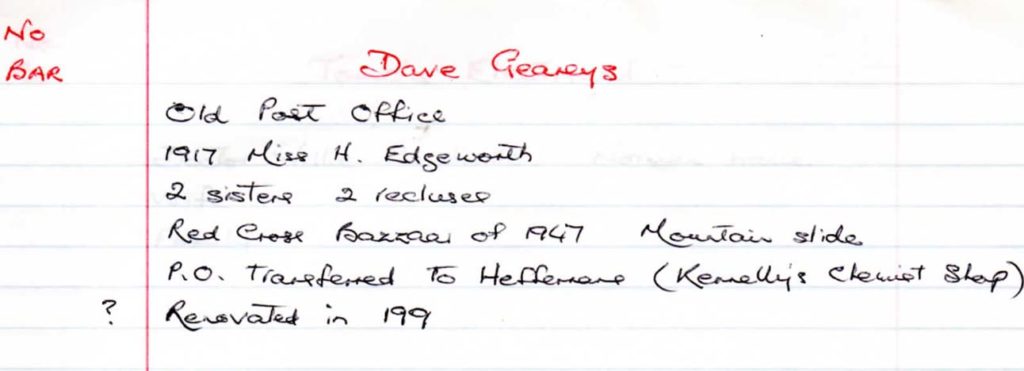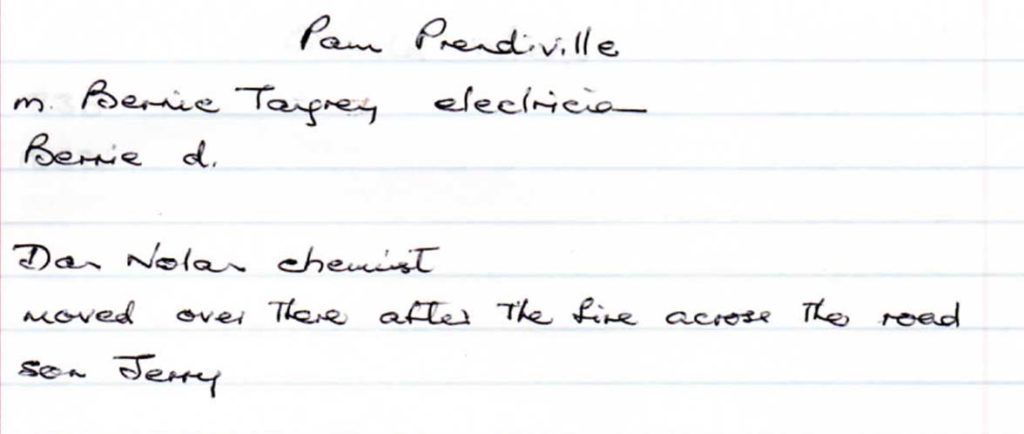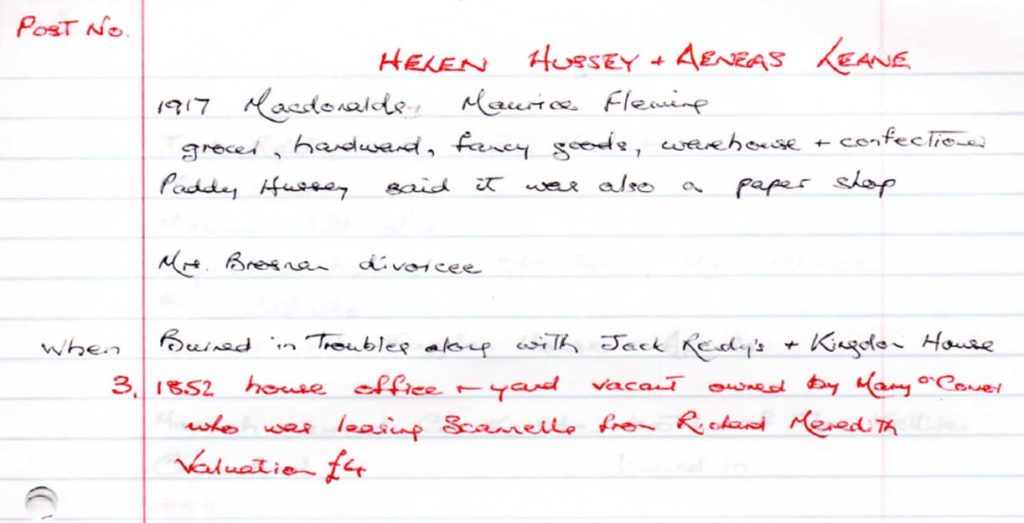Castleisland was central to Michael O’Donohoe’s historical research. He studied the buildings in the town and vicinity and compiled notes about businesses and proprietors from Griffith’s Valuation and other sources.
Michael’s study included Barrack Street/Lane, Limerick New Road, Spout Lane, Main Street, Church Lane, Tralee Road, Chapel Lane/Street/Quarter, New Line and Pound Lane.
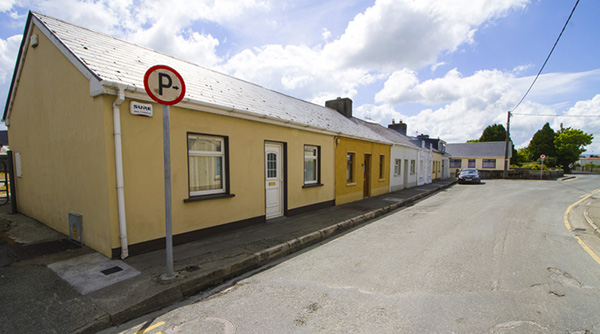
Pound Lane
Michael added to his notes the recollections of T M Donovan who described Pound Lane as once ‘full up to the brim’:
Thank goodness most of the dwellers in Pound Lane have long ago gone out into the comfortable labourers’ cottages now lining the roads in all directions.1
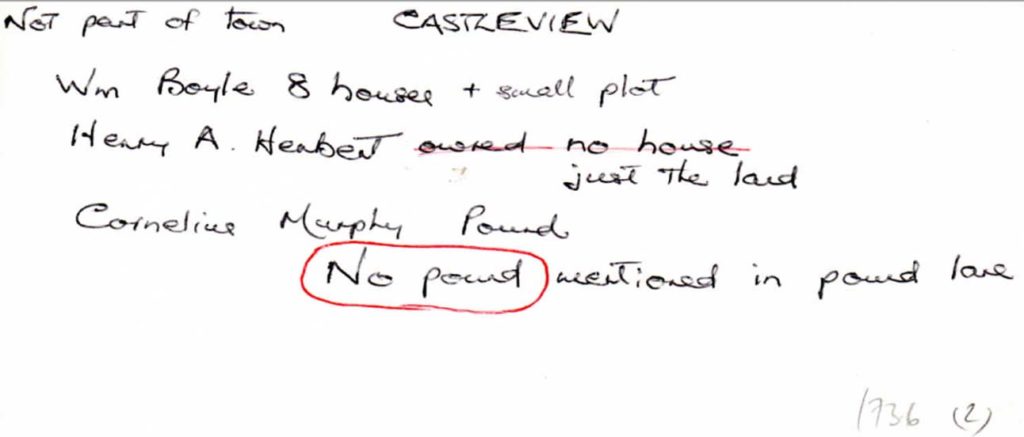
Donovan described how in the early nineteenth century, landlords ‘made a clearance of all their small tenants, evicted them, and threw themselves and their families on the side of the road’:
Many of them came into the town of Castleisland, then a village, and made their mud cabins on what is now called Pound Lane. As a boy of nine, seventy years ago, I knew well the hard-working decent men who lived in these small thatched cottages in Pound Lane. Most of them were the sons and daughters of the evicted men who built them.2
In the late nineteenth century, Pound Lane had become ‘a slum’ but some cottages were still occupied in the 1930s and 1940s:
Many of the old cottages fell to pieces or were demolished but about a dozen still remain and are occupied by poor people … many of them were condemned as unfit for habitation and the occupiers are threatened with the fate of their grandparents – eviction.
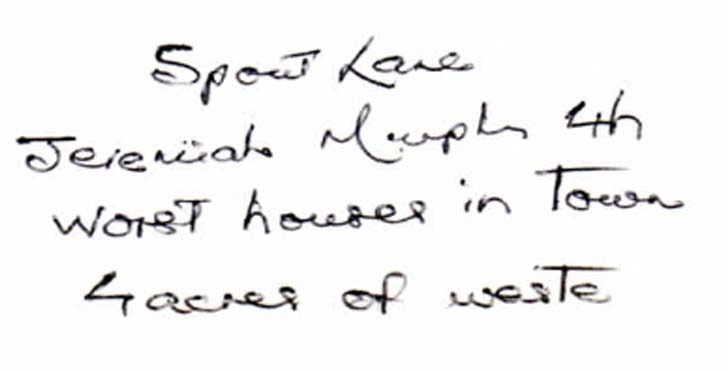
Old and New Chapel Lane
The history of old and new Chapel Lane dates to the eighteenth century:
In or about the year 1766 the Rev Darby Shanahan built the thatched chapel in old Chapel Lane and Rev Maurice Fitzgerald built the first stone and slated church in New Chapel Lane, now Church Street.3
New Line
A story is told of the New Line and how one Henry Williams and his father John, dyers, used to carry the dyed cloths from the New Line via the Main St and Barrack Lane to the old bridge to wash them, ‘once Henry wheeled his cart past the police barracks with his dyed cloths covering a barrel of guns. He had nerve’.4
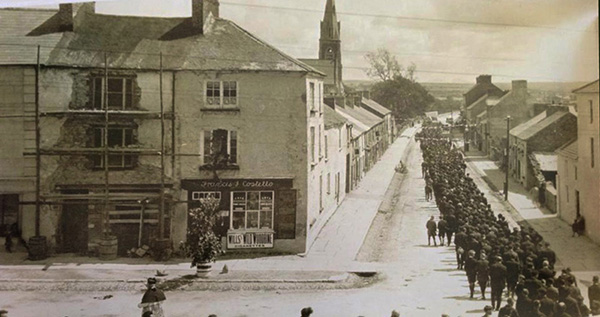
Powell’s Road
Killarney Road led to ‘the well-known Powell’s Road’:
For the townsman confined indoors by his business a walk round Powell’s road is just the refresher he wants as it is just the length the doctor ordered – three miles.5
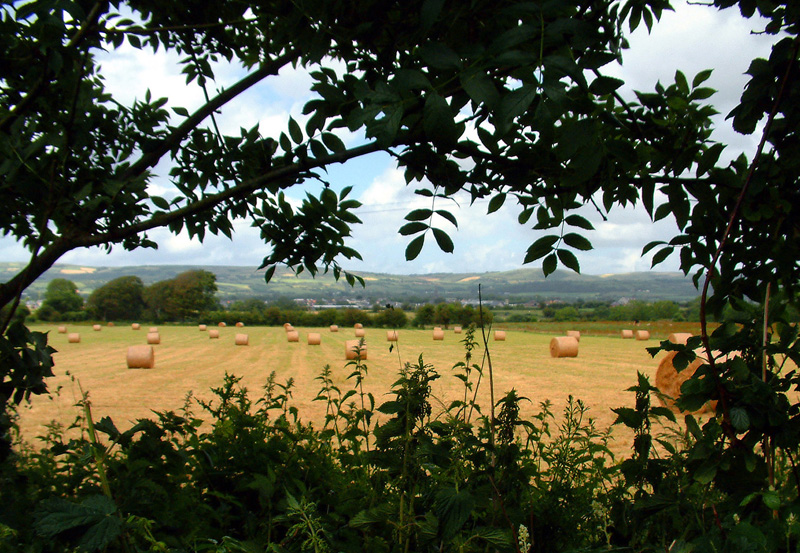
Market House
The Market House dates to 1747. Michael recorded that ‘each of the six [seigniory] had a share in the old Market House’ (IE MOD-1-1.1-1.1.1) which was built from local materials:
They built a market house with an assembly room out of the debris of the great Castle.6 Out of the same material they erected an infantry barrack for 100 men whence and by aid of their assembly room some of their friends got husbands for their young ladies from among the officers.7
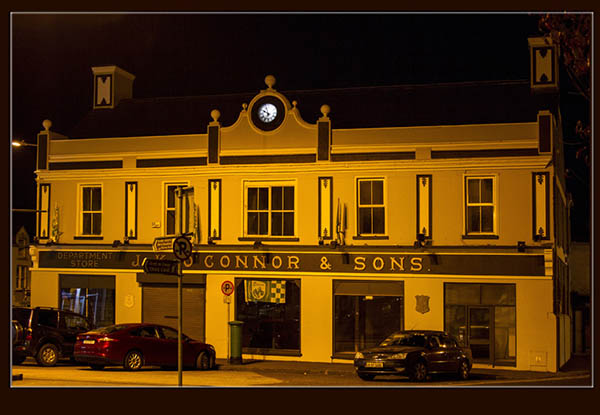
The Market House, which closed in 2014, was purchased by J K (John Kerry) O’Connor from Lord Headley c1907. Michael’s notes on J K reveal that the property had earlier been in the hands of the family of Miss Ellie Burke ‘for 150 years’.
Kingdom House Burned
To some of the town’s businesses, Michael added contemporary notes of his own.
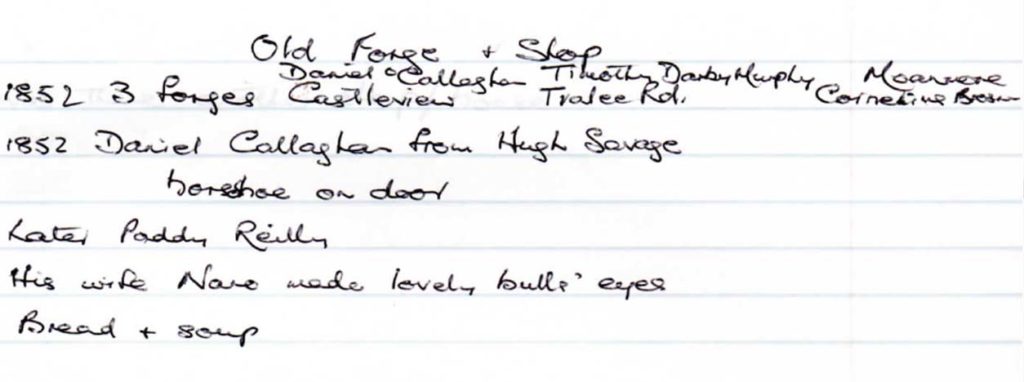
Of the old post office, Michael wrote, ‘1917 Miss H Edgeworth, 2 sisters, 2 recluses … post office transferred to Heffernans (Kennelly’s Chemist Shop) Renovated in 199?’.
Dan Nolan, chemist, he wrote, relocated ‘after the fire across the road’.
And the Kingdom House was burned during the Troubles.
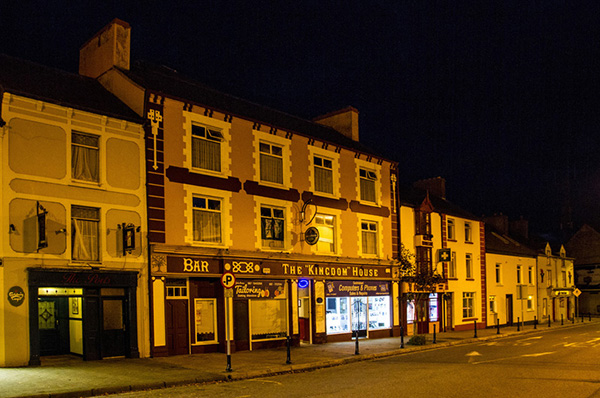
_________________________
1 From T M Donovan's six-part Old Times in Castleisland: Rambling Reminiscences published in the Kerryman in 1925 ( Part 2, 28 March). The demolition of 'a thoroughfare called Pound-lane, Castleisland' was ordered by Mr Balfour in 1890 owing to the insanitary state of the houses. The Sanitary Committee refused to comply because the step was recommended by T W Russell, MP (Lancashire Evening Post, 12 May 1890). 2 The Kerryman, 16 August 1941, 'In a Rich Munster Valley'. 3 Ibid. 'Maurice Fitzgerald was the nephew of the Penal Days parish priest of Castleisland (1781-1830), the Rev Maurice Fitzgerald, whose memorial tablet is now hidden from view in the new parish church. Since 1766, this parish church built in 1884 was the third since the Penal Days when Mass was offered in the Glen-an-Affrins or in mud cabins in the bogs or mountains.' 4 Kerryman, 25 April 1925, 'Old Times in Castleisland, Rambling Reminiscences'. 5 Old Times in Castleisland: Rambling Reminiscences published in the Kerryman in 1925 (Part 4, 11 April). In another article, Donovan wrote, 'The black road and the Knockaunban road, now bohereens, are in dry weather used as a circular walk by our townspeople instead of the longer walk round Powell's Road. What memories even the mention of these two walks will bring to the minds of Castleislanders far away in foreign lands!' (Kerryman, 11 October 1930, 'English Settlers in East Kerry'). Michael O'Donohoe Memorial Committee Chairman, John Roche, recalls how Powell's Road was once 'black with people walking it'. The old Roche homesteads are located in this area. 6 Tralee Chronicle and KIllarney Echo, 5 December 1873. The Market House was rebuilt in 1825 of stone and lime and slated with rooms for an agent's office, school and reading, petty sessions and caretakers apartment. The middle under part was the market House (IE MOD 45/45.1/45.1.6). There is an image of Market House Corner in the nineteenth century in Castleisland Church and People (IE MOD/6/6.1/6.1.20) and another, from the same source, taken c1914 (IE MOD/6/6.1/6.1.15 ). In this year it was remodelled (IE MOD/14/14.2) and in 1997, it was renovated and extended (IE MOD/14/14.2). A sketch of its history was published in the Maine Valley Post, 26 July 2014, 'The Market House 1747-2014'. 7 Ibid. For many years Lord Brandon occupied apartments in the barracks of Castleisland by permission of the government; his glebe house he leased to Mr Chute. In 1819, when Oliver Stokes Esq was Barrack Master, an action of trespass vi et armis was taken against Lord Brandon by Edward King, who kept a tavern at Castleisland. King claimed Lord Brandon had assaulted him and dragged him down the stairs of the barracks after the nobleman was irritated by the noise from King's winnowing machine (Saunders's News-Letter,17 August 1819). Castleisland barracks was advertised for sale or lease in 1820; a list of freeholders in Kerry published in 1829 revealed that the barracks was the property of Francis Twiss Esq of Bally-M'Egogae. Note: Bally-M'Egogae (Bally-M'Engogue, Ballymakegoge, BallymacEgoge, Baile Mhic Thaidhg Oig) probably relates to the townland of Ballymackegoge at Fenit which developed as a spa and health resort in the nineteenth century. Properties included two Spa Lodges (one later named Barnacle House, residence of the Jeffcott family), two Sea Views (one later named Glenmore, residence of Mr James Johnston, leading member of the Kerry Coursing Club and son of Mr Johnston of Ballygarran); Eden Cottage (later Seafield, associated with the Donovan family notably Nicholas Donovan, DL (1815-1877) and his brother Sir Henry Donovan, JP (1823-1886). Both highly regarded for their services to the town of Tralee, 'had Sir Henry not taken up the project of the Fenit pier and railway, in all probability it would have fallen through'. St John Henry Donovan, JP (1863-1916) was the only son of Sir Henry; St John died at Seafield on 4 February 1916. Miss Frances Donovan of Seafield and of the Order of Sisters of Mercy laid the corner stone of the convent at Moyderwell in 1878. The contents of the house were sold by Mr H B Donovan in 1930. Some genealogy in funeral report of Nicholas Donovan published in Cork Examiner, 13 November 1877); White Lodge; Bay View; Oyster Hall (residence of solicitor Daniel Supple Esq. Daniel Supple senior and junior died in January and March 1845 respectively. The property was subsequently leased by Miss Arabella Supple before being sold in 1852 and purchased by William John Neligan for £1,400. The Supple family grew black minion potatoes at Oyster Hall); Massyville; Ivy Lodge; Rock Villa; Bath Lodge (and a coast guard station abandoned for more suitable premises c1848). See Kerryman, 5 December 2002, 'Spa should capitalise on Well's reputed curative powers'.


